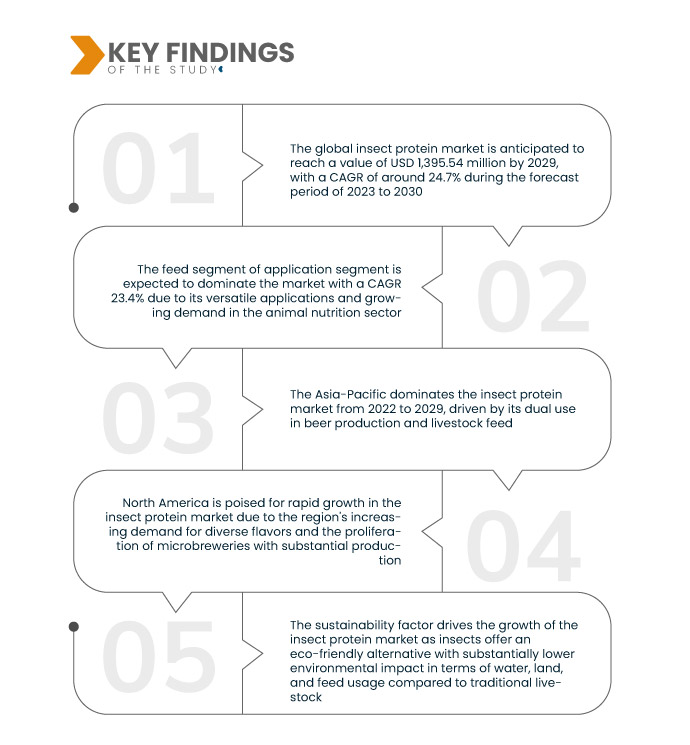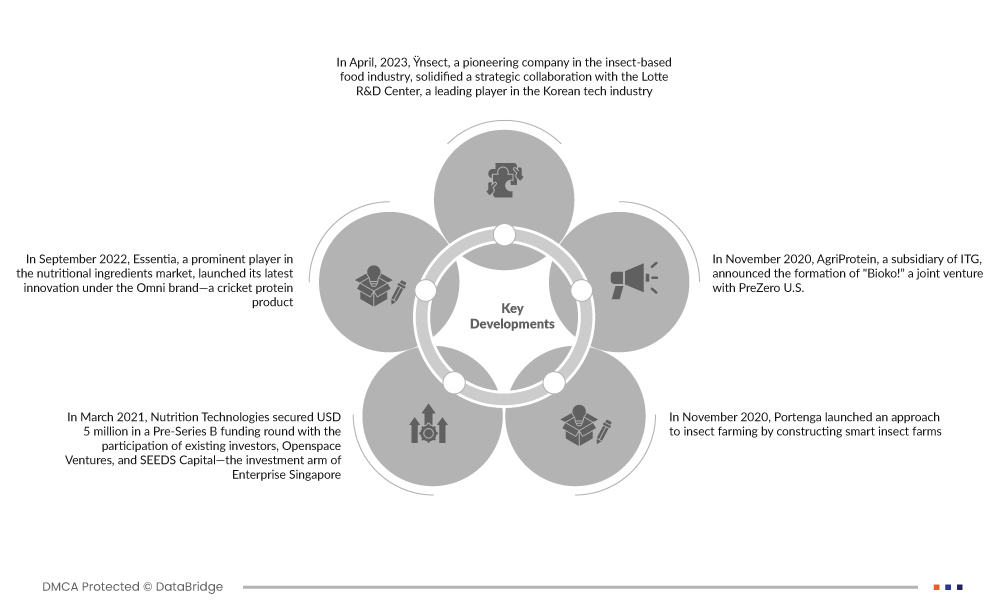The exceptional nutritional density of insect protein underscores its importance in addressing global nutritional challenges. Insects are rich sources of high-quality proteins and provide essential healthy fats, vitamins, and minerals crucial for a well-rounded and balanced diet. As the world faces increasing concerns about food security and the need for sustainable protein sources, the nutritional richness of insect protein becomes particularly relevant. Its ability to offer a comprehensive spectrum of nutrients makes it a valuable option for meeting the dietary requirements of a growing global population. Embracing insect protein aligns with the intention to diversify protein sources, ensuring nutritional adequacy, and promoting sustainable food practices globally.
Access full Report @ https://www.databridgemarketresearch.com/reports/global-insect-protein-market
Data Bridge Market Research analyses the Global Insect Protein Market was valued at USD 543.67 million in 2021 and is expected to reach the value of USD 1,395.54 million by 2029, at a CAGR of 24.7% during the forecast period 2022-2029. The nutritional richness of insects, abundant in essential proteins, vitamins, and minerals, is a key driver in the insect protein market.
Key Findings of the Study
Increasing expansion of insect protein into various applications is expected to drive the market's growth rate
The expansion of insect protein into various applications, including human consumption and animal feed, is a significant driver for the market. Beyond meeting the dietary needs of humans, insect protein plays a crucial role in enhancing the nutrition of animals in aquaculture and livestock industries. This diversification broadens the market's reach and contributes to the growth of associated sectors. As insect protein gains traction as a sustainable and protein-rich ingredient in animal feed, particularly in aquaculture and livestock, it aligns with the global shift towards more environmentally friendly and efficient protein sources. This dual application enhances the economic viability of the insect protein market, positioning it as a versatile and integral component of the broader food and feed industries.
Report Scope and Market Segmentation
Report Metric
|
Details
|
Forecast Period
|
2022 to 2029
|
Base Year
|
2021
|
Historic Years
|
2020 (Customizable to 2014-2019)
|
Quantitative Units
|
Revenue in USD Million, Volumes in Units, Pricing in USD
|
Segments Covered
|
Insect Type (Beetles, Caterpillars, Bees, Wasps and Ants, Grasshoppers, Locusts, Crickets, True Bugs, Black Soldier Flies, Cicadas, Leafhoppers, Plant Hoppers, Scale Insects, Termites, Dragonflies, Flies, Mealworms and Others), Application (Food and Beverage, Feed, and Pharmaceuticals and Cosmetics), Distribution Channels (Direct and Indirect),
|
Countries Covered
|
U.S., Canada and Mexico in North America, Germany, France, U.K., Netherlands, Switzerland, Belgium, Russia, Italy, Spain, Turkey, Rest of Europe in Europe, China, Japan, India, South Korea, Singapore, Malaysia, Australia, Thailand, Indonesia, Philippines, Rest of Asia-Pacific (APAC) in the Asia-Pacific (APAC), Saudi Arabia, U.A.E, South Africa, Egypt, Israel, Rest of Middle East and Africa (MEA) as a part of Middle East and Africa (MEA), Brazil, Argentina and Rest of South America as part of South America.
|
Market Players Covered
|
Aspire Food Group (U.S.), EntomoFarms (Canada), Protifarm (Netherlands), Jimini’s (U.K.), Chapul Cricket Protein (U.S.), Swarm Nutrition GmbH (Germany), AgriProtein Holdings Ltd. (South Africa), EnviroFlight LLC (U.S.). Innovafeed (France), Ÿnsect (France), Hexafly (Ireland), Protix (Netherlands)
|
Data Points Covered in the Report
|
In addition to the insights on market scenarios such as market value, growth rate, segmentation, geographical coverage, and major players, the market reports curated by the Data Bridge Market Research also include in-depth expert analysis, geographically represented company-wise production and capacity, network layouts of distributors and partners, detailed and updated price trend analysis and deficit analysis of supply chain and demand.
|
Segment Analysis:
The global insect protein market is segmented on the basis of insect type, application and distribution channel.
- On the basis of type, the global insect protein market is segmented into beetles, caterpillars, bees, wasps and ants, grasshoppers, locusts, crickets, cicadas, leafhoppers, planthoppers, scale insects, true bugs, termites, dragonflies, flies, mealworms, black soldiers, and others. The beetles segment is dominating the market due to the extensive diversity within the beetle species, offering a wide range of nutritional profiles with a CAGR of 25.4%
The beetles segment of type segment is expected to dominate the global insect protein market during the forecast period of 2022-2029
The beetles segment type segment is expected to dominate in the global insect protein market with a CAGR of 25.4% due to a diverse and abundant group of insects, offering a wide range of species suitable for protein extraction. Many beetle species have high protein content, making them a favorable choice for insect protein production. Additionally, beetles are often more resilient and adaptable to various environmental conditions, facilitating their cultivation on a larger scale. Their versatile nature and nutritional profile make them an attractive option for addressing the increasing demand for alternative protein sources.
- On the basis of applications, the global insect protein market is segmented into food and beverage, feed, pharmaceuticals, and cosmetics. The feed segment is dominating the market due to the increasing demand for sustainable and high-quality animal feed, with a CAGR of 23.4%
The feed segment of the application segment is expected to dominate the global insect protein market during the forecast period of 2022-2029
The feed segment is expected to dominate the global insect protein market with a CAGR of 23.4% due to its versatile applications and growing demand in the animal nutrition sector. Insect protein serves as a high-quality and sustainable source of nutrition for livestock, poultry, and aquaculture. With an increasing global population and rising demand for animal-derived products, there is a growing emphasis on enhancing livestock and aquaculture feed efficiency and sustainability. Insect protein, rich in essential amino acids and nutrients, addresses these concerns effectively.
- On the basis of distribution channels, the global insect protein market is segmented into direct and indirect. The direct segment is dominating the market due to the increasing trend of direct-to-consumer sales and online retail platforms with a higher CAGR of 24.5%
Major Players
Data Bridge Market Research recognizes the following companies as the major global insect protein market players in global insect protein market are Aspire Food Group (U.S.), EntomoFarms (Canada), Protifarm (Netherlands), Jimini’s (U.K.), Chapul Cricket Protein (U.S.), Swarm Nutrition GmbH (Germany)
Market Developments
- In April, 2023, Ÿnsect, a pioneering company in the insect-based food industry, solidified a strategic collaboration with the Lotte RandD Center, a leading player in the Korean tech industry. This collaboration marks a significant milestone in advancing insect-based food throughout Asia. The partnership is underscored by signing a Memorandum of Understanding (MOU), symbolizing Ÿnsect's steadfast commitment to raising awareness and fostering opportunities for insect-based food and beverages in the region. The joint efforts aim to accelerate the development and acceptance of insect-derived products in Asia, leveraging the expertise and resources of both Ÿnsect and Lotte RandD Centre
- In September 2022, Essentia, a prominent player in the nutritional ingredients market, launched its latest innovation under the Omni brand—a cricket protein product. This novel addition joins Essentia's existing lineup of nutritional offerings, which includes collagen peptides and bone broth powders. The introduction of cricket protein aligns with Essentia's commitment to providing diverse and sustainable nutritional options, tapping into the growing interest in alternative protein sources. The Omni brand's cricket protein product represents a strategic move to meet evolving consumer preferences and contribute to the sustainable future of the food industry
- In March 2021, Nutrition Technologies secured USD 5 million in a Pre-Series B funding round with the participation of existing investors, Openspace Ventures, and SEEDS Capital—the investment arm of Enterprise Singapore. The funding injection is earmarked for establishing an insect protein factory in Malaysia. This strategic move positions Nutrition Technologies to not only expand its presence in the Southeast Asian markets but also fuel research and development initiatives. The investment signifies growing confidence in the potential of insect-based protein and its role in addressing global food challenges
- In November 2020, Portenga launched an approach to insect farming by constructing smart insect farms. These modular and decentralized farms are strategically located near waste biomass sources to overcome the cost and sustainability challenges associated with centralized insect-based farming systems. With the capacity to process 20-60 metric tonnes of feedstock per day, these smart insect farms represent a significant leap forward in sustainable agriculture. Portenga's innovative solution not only addresses environmental concerns but also enhances the scalability and efficiency of insect protein production
- In November 2020, AgriProtein, a subsidiary of ITG, announced the formation of "Bioko!” a joint venture with PreZero US. PreZero, a German-based company recognized for its global recycling initiatives, partnered with AgriProtein to establish an operating entity in the United States focused on nutrient recycling processes. This collaboration harnesses the expertise of both companies to develop circular economy solutions. By combining AgriProtein's insect-based technologies with PreZero's recycling capabilities, "Bioko!" aims to play a pivotal role in advancing sustainable practices in the U.S. and beyond
Regional Analysis
Geographically, the countries covered in the global insect protein market report are U.S., Canada and Mexico in North America, Germany, France, U.K., Netherlands, Switzerland, Belgium, Russia, Italy, Spain, Turkey, Rest of Europe in Europe, China, Japan, India, South Korea, Singapore, Malaysia, Australia, Thailand, Indonesia, Philippines, Rest of Asia-Pacific (APAC) in the Asia-Pacific (APAC), Saudi Arabia, U.A.E, South Africa, Egypt, Israel, Rest of Middle East and Africa (MEA) as a part of Middle East and Africa (MEA), Brazil, Argentina and Rest of South America as part of South America.
As per Data Bridge Market Research analysis:
Asia-Pacific is the dominant region in the global insect protein market during the forecast period 2022-2029
The Asia-Pacific dominates the insect protein market from 2022 to 2029. This dominance is fueled by the dual utility of insect protein in catering to the escalating demand for beer production and sustainable livestock feed. The region's population's increasing disposable income further propels the adoption of insect protein as a nutritional and eco-friendly food choice, aligning with evolving consumer preferences. Moreover, supportive regulatory environments in Asia-Pacific contribute to the favorable insect protein market growth landscape. These factors underscore the region's pivotal role in shaping the trajectory of the insect protein market in the coming years.
North America is estimated to be the fastest-growing region in the global insect protein market for the forecast period 2022-2029
North America is expected to dominate in the insect protein market due to the increasing popularity of diverse flavors and the proliferation of microbreweries with significant volumetric production. The region's consumers are drawn to unique taste experiences, fostering a demand for innovative food products such as insect protein that offer novel culinary options. The rising trend of microbreweries in North America incorporates insect protein as a sustainable and protein-rich ingredient, aligning with the growing preference for eco-friendly practices. This synergy between diverse flavors and the microbrewery scene positions North America as a promising market for insect protein, reflecting the region's dynamic culinary landscape and sustainability-driven consumer choices.
For more detailed information about the global insect protein market report, click here – https://www.databridgemarketresearch.com/reports/global-insect-protein-market












